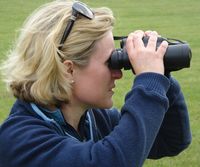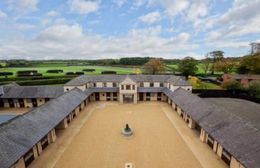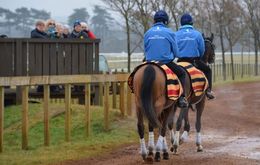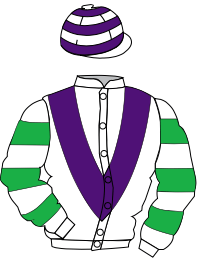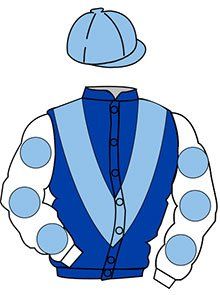Welcome to Saint Wendred's
Racehorse Trainers in Newmarket
The Trainer / Veterinarian
Newmarket based thoroughbred trainer and practising veterinarian, Ilka was an apprentice jockey in Germany and an assistant trainer in the US. She graduated from vetschool in 2009 and completed the British Trainer’s Course in 2012
Sole UK Distributor
The Horses
The Facility
Racehorse Ownership
Ownership and/or a Racing Club Membership gives you a wonderful opportunity to participate and to be actively involved with horse racing, on the inside.
Get Close to the Action!
And Come Racing!
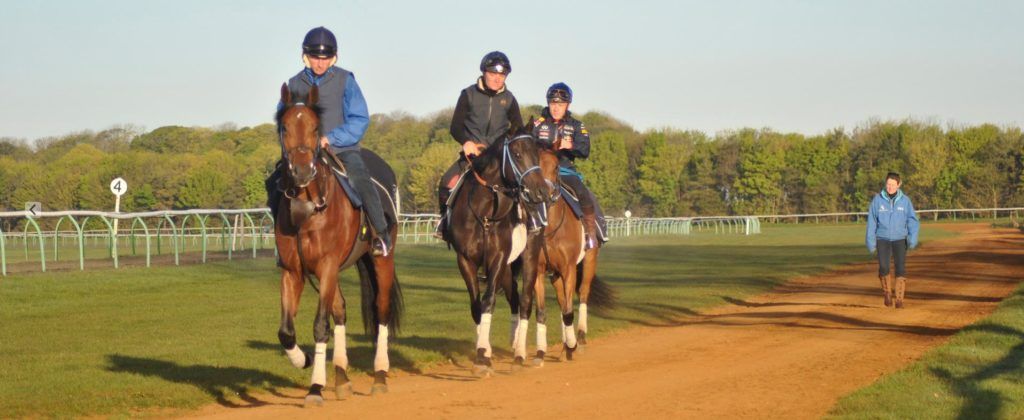
Do you ever people watch and notice the different ways people walk? If you do, you’ll see that walks can vary hugely between people…how they move their arms, if they’re one-sided, or how much up and down motion there is! Us equine professionals may be more guilty of this than most – after all, we’re used to assessing gaits for soundness and so on.
In a gait where there are so many variations in movement, one thing I always look for, in both humans and horses – is a purposeful walk. I believe it conveys a lot about the individual and so here are my thoughts on a purposeful walk in humans and horses…
Humans
There is one situation where a purposeful walk is a great indicator to me – conducting job interviews.
As an employer, one of the main characteristics I’m looking for is enthusiasm. So much can be taught, but attitude and enthusiasm have to be there already. When a candidate walks into the yard, they should be seeking to make a good first impression and having a purposeful walk is one thing that can make an immediate difference to the candidate’s body language and how they come across.
There’s no disputing that working in a racing yard is hard work and so you’ve got to have enthusiasm. If a candidate can’t muster that in a basic walk, at the point at which they’re trying to impress at interview – I’d be surprised to see any purpose or enthusiasm when they’re mucking out! There’s much to gain from a life in racing, it’s interesting, varied, exciting and there’s always plenty to learn. The prospect of landing a job in your chosen industry really should put a little bit of a spring in your step. I can understand nerves are a hindrance to many aspects of interview technique and I make allowances for that, but I do not believe nerves give you a lacklustre walk!
So, give me a purposeful walk and you’re halfway to the job. I need workers who see work as an opportunity, those who want to take work on, people I can delegate to confidently, who’ve got a sense of urgency about getting things done. I’m looking for people who show initiative and work well with the team. You don’t need to know everything, but you do need enthusiasm, a good attitude and to be willing to learn.
Horses
To some extent horses can be easier to read than humans! We’re well used to observing and making our own minds up in regards to how fit and well they might be feeling. You can use your instinct a lot more clearly with horses, whereas humans can alter your first impression or perspective with words!
In horses, the walk is very important. I believe an active purposeful walk demonstrates that the horse has the attitude to take things on and will ultimately be more enthusiastic about their day-to-day work. I usually assess the walk at three distinct stages where it’s of particular importance – purchase, training and at the racecourse.
When purchasing at the sales, the way the horse walks is one of the key factors for consideration and assessment. Large sums of money are invested and so assessing the walk properly is critical. Fortunately, a walk can tell you a great deal and is a very good indication of the way the horse will move in the other gaits. As a vet, I have an advanced awareness of gait analysis and personally, I look at the way the horse uses himself, his natural biomechanics, for fluidity of movement, good use of the back muscles and the hind legs coming through underneath with properly engaged hindquarters. Just some of the observations I make are – the natural nodding of the head, the carriage of the head, the swing through the body, the length of the stride (particularly the back feet), the range of movement in the shoulder, how level the hips are, muscle tone and development and the tightness of the muscles; and again I like the horse to look like he’s walking with some purpose.
I like to leave no stone unturned and for me, a purposeful walk is part of the day-to-day training of the horse. It’s part of the daily exercise routine and I assess the walk whenever possible. By this, I don’t mean just putting them on the horse-walker I mean using the walk to and from the gallops as part of the training. I like to see the horses with a strong, fluid, purposeful walk, with some urgency yet moving in a relaxed way. They need to be actively walking on, with engaged hindquarters and stretching the head down and using the back muscles properly. To train winners, you need horses that want to go forward, that want to take the work on, and a good marching purposeful walk in training reflects a good attitude to work in the horse.
Once at the racecourse – I make a brief assessment of whether the horse travelled well and how he’s feeling. In the parade ring, you obviously get a clear indication as to how on their toes they are and I’d be very surprised to see a horse that doesn’t have a purposeful walk with all the added excitement of the racecourse.
So, a purposeful walk is the main thing I look out for in horses and humans – and there’s a big tip for anyone interviewing with me! Like Bill O’Gorman says “this is not a rehearsal!”
I’m heading to the Guineas Breeze Up & Horses in Training Sale later this week on 3rd and 4th May. If you’re thinking of purchasing a horse and require any assistance from either a Trainer or Veterinarian perspective I’d be happy to assist you .

Guest post by: Dr. Cath Dunnett of Independent Equine Nutrition (IEN).
There are intrinsic contamination risks associated with horse feed and supplements which have in recent years been responsible for a series of post-race positives. Contamination of feed principally occurs due to the accidental introduction of an ingredient containing a naturally occurring prohibited substance. There are many stages in feed production and accidental contamination could happen at several stages, for example, contamination with weeds containing prohibited substances during the growth of cereal or other ingredients. Inadvertent contamination could also occur during harvest through the sharing of equipment or storage, or during cross-contamination during shipping or transport to the mill. There is potentially an increased risk of such contamination as a larger number of ingredients are sourced from across the globe and feed and supplement production becomes a worldwide operation.
Naturally Active Compounds
The feed industry takes the risk of contamination incredibly seriously and strategies have been implemented to reduce contamination risks from ingredients both produced at home and imported. Broadly the feed industry has a very good knowledge where the risks for contamination with prohibited substances lie, however, these can be complicated when additives such as herbs, spices, or plant extracts are used in feed or supplements. Here there are two key considerations – firstly, many plants naturally contain pharmacologically active compounds that could be considered as prohibited substances. Secondly, the country of origin may lack sufficiently thorough quality control systems.
The post-race positives due to morphine contamination of feed were reportedly due to poppy seed contamination of one or more ingredients. It may be a surprise to many that morphine-containing poppies had until recently been harvested in various locations around the UK, under a specific license and strict control and management, for the production of pharmaceuticals. A greater amount of morphine is found within the poppy seed head, whereas the seeds themselves contain only a very low level of morphine. It’s worth mentioning that the commonly seen red field poppies do not present a notable contamination risk, as they contain very low levels of morphine, if any at all.
Interestingly, in human food production, fragments of poppy seeds and heads do infiltrate the food chain. Yet, the European Food Standards Agency (EFSA) does not list morphine as an undesirable substance and there remains no minimum legal limit for morphine in human food.
Significant Physiological Levels In Racehorses
Whilst the potential for low residual levels of morphine in the food chain may be physiologically inconsequential to humans, it remains extremely problematic to trainers. Morphine is a significant analgesic and therefore must be regulated in a way that prevents its potential for abuse. Investigations into contamination might successfully conclude that any post-race positive test was as a result of feed contamination, however, it remains the case, that the horse has raced with a level of the ‘drug’ in its system.
Prohibited substance testing is incredibly accurate and a positive post-race result will be returned on minute levels. Whilst regulatory bodies over the world may choose to take a pragmatic view, nevertheless, there is no ‘official’ threshold for morphine in post-race samples in racehorses, therefore, a line must be drawn. For welfare reasons, there is no scientific evidence to allow us to determine an acceptable level where no physiological effect is confirmed.
Scheme Accreditation
The UK feed industry developed a quality assurance code as a risk management measure to reduce the risk of prohibited substances entering equine feed and to safeguard the interests of consumers and feed producers and suppliers.
The aim of any such quality assurance scheme is to understand where the risks lie within each part of the supply chain and then how to mitigate those risks. Here are a few areas where such a scheme can assist:
- Ensuring a long-term relationship with suppliers.
- Using an appropriately accredited manufacturing facility.
- Ensuring that everyone involved in the supply and manufacturing chain, including, farmers, harvest contractors, processors, hauliers, storage suppliers, trainers and stable staff understand the importance and the risks posed by prohibited substances and the consequences of minute levels of contamination.
- Encouraging collaboration between different manufacturers, so that concerns regarding ingredients or products, can be shared following analysis.
- Ensuring that marketing claims regarding prohibited substances are factual and not misleading.
Accredited companies are likely to be audited annually, to ensure their compliance with the scheme and that robust quality control systems remain in place to reduce the risk of contamination by prohibited substances.
Gathering Information
In addition to the efforts made by the equine feed industry, trainers themselves have a responsibility to understand the contamination risks and actively manage them. After all, it’s the trainer’s reputation and livelihood that is at stake. Trainers may receive some advice on this from their regulatory bodies and in the UK whilst attending the BHA trainer licensing course and any NTF seminars on the subject.
So far as is possible, trainers must be totally aware of the constituent parts of everything that is fed to their horses. This information is readily available, as it’s a legal requirement for companies to provide such details on the packaging.
Trainers would also be advised to enquire about the quality control systems that their manufacturer has in place to reduce the risk of contamination with prohibited substances. This could involve comprehensive risk assessments, raw material traceability and testing of both the ingredients and the finished product in some cases. Regardless of the size of the business, or their supply structure, all companies should have a robust system of traceability and quality control. For instance, my own company Racing Blue, follow a thorough quality control program in the manufacture of STORM ® Equus that includes every batch of each raw material and finished product being tested for a wide range of prohibited substances prior to release for sale.
Where a trainer uses a product manufactured abroad, sufficient questions of the importer/marketer should be asked, to ensure their processes match those in the home country. For instance, certain substances that are allowable in agricultural feed production in other countries, may be regarded a prohibited under the Rules of Racing in the home country.
Daily Management Procedures
It’s advisable for trainers to implement additional feed procedures in the yard, such as maintaining a comprehensive list of feedstuffs given to individual horses. This proves extremely useful should a post-race sample return as positive. Further to this, keeping an accurate record of delivery dates, batch numbers and invoices, as well as retaining a copy of all associated delivery notes and other paperwork, provides further evidence, if needed, to establish the route of contamination. Better still, retaining samples of each batch of feed and supplement for about 3 months is an excellent process to implement, as this is the period of time over which a post-race positive is possible and the consequent regulatory process will last. Representative samples of feed (500g) and a supplement (100g) should be stored in a sealed plastic bag and labelled with the product name, batch code and purchase date. Should an investigation be necessary, the record keeping along with the feed samples will provide vital evidence. Feed or supplement manufacturers should also retain samples for re-examination if a problem arises, however, it’s a sensible precaution for trainers to do the same.
Quality control processes and accreditation schemes have brought considerable benefit to the racing industry, however, historical positive cases with morphine and other substances demonstrate that accidental contamination can still happen, and there are always further improvements that can be made. Equally however, trainers have a pivotal role and must ensure they keep informed and up to date, so that they’re able to make the best possible feeding and feed management choices.
You can find out more about feed analysis on the IEN website.
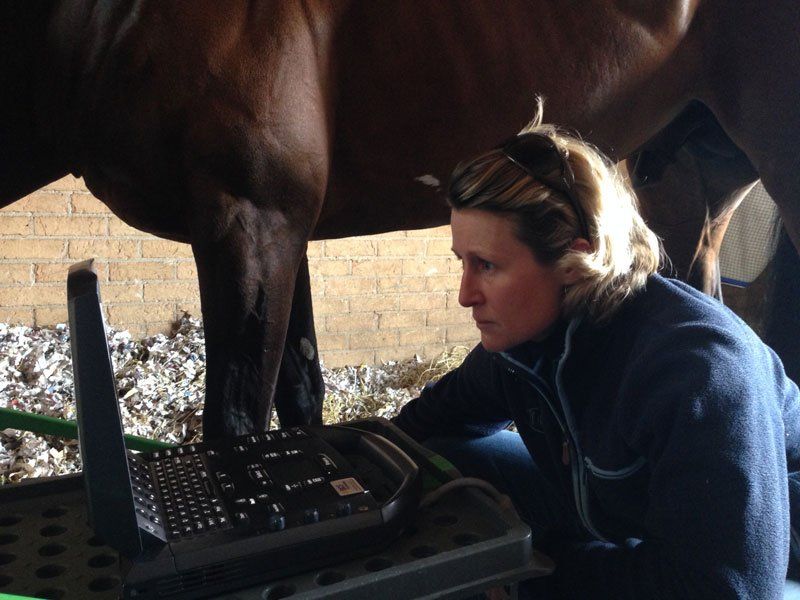
All businesses want a unique selling point (USP). However, with around 400 licensed flat trainers in the UK and as with market competition in any industry – finding, retaining or even explaining a USP can be tough!
IGL Racing has an immediate USP – that I’m the only female trainer that’s also a qualified vet in the UK. Horses under my training and subsequently their owners, benefit from having a vet on site 24/7. Through my veterinary experience, I’ve developed an advanced knowledge and awareness of soundness and wellbeing; which means I can often prevent an injury by spotting a potential problem in the early stages. This has obvious immediate benefits to the welfare of the horse, along with benefits to the owner both financially in reduced vets bills and in terms of their enjoyment; as their horse stays fit and well and able to race more regularly.
Having an obvious USP is quite rare in today’s competitive marketplace; yet being unique is about more than just one statement of fact – it goes beyond that. We’ve all taken a unique course and have grown through a unique set of experiences to get to who we are and where we are today. Uniqueness as a racehorse trainer is really about the combination of your skills, knowledge and experience and how this distils down into your approach to training.
Here are 6 points that I believe combine to make IGL Racing unique…
#1 Innovation
In both training and business, I believe in marginal gains, taking every opportunity, evolving and innovating. I’m driven to think differently, cover all the bases and experiment with new methods. The marginal gains approach looks at making constant improvements, however small, across every element of training. It’s often the little things that make a big difference with racehorses, particularly to how they feel within themselves, for example, some fresh grass or a bit of freedom in the paddock. We look at every element of training, nutrition, stabling, equipment, air quality, transportation and more!
#2 Ambition
OK, so having ambition is not unique, particularly in racing! However, I have big ambitions and from my early days as an apprentice jockey in Germany, my aim was always to become a trainer. Over the years, I’ve purposefully gained a wide range of experiences, knowledge and qualifications, including working as a vet and learning natural horsemanship, in order to develop a deep understanding of the horse and provide a solid foundation as a trainer.
My mission now is to train winners. The horses I have in training at the moment are a solid start to this ambition. I have the capacity at Saint Wendred’s and look forward to growing the number of horses in training and gaining momentum on the racecourse with an increase in runners.
#3 Excellence
Racing itself is the pursuit of excellence. The thoroughbred racehorse is a result of centuries of breeding and can be thought of as the ultimate pursuit of excellence. I have always striven for excellence, for both myself and my training operation. I’m determined to continue going that extra mile in the pursuit of excellence.
#4 Approach
My training approach combines both tradition and innovation, veterinary science and natural horsemanship. I incorporate diagnostics and scientific measurements to support my horsemanship knowledge and of course am always on-hand with veterinary knowledge when needed. The horses benefit from this, as it ensures they are monitored at every possible point. Here’s just some of the science supporting my training… cryotherapy, pulsmagnetic therapy, GPS, nutritional supplements, hay steamer and the new ComfortStall rubber matting system.
#5 Welfare
Saint Wendred’s is a bespoke, purpose-built yard, with excellent training facilities in Newmarket. It allows me to fulfil my first and foremost priority – the horse’s welfare. I’m dedicated to the wellbeing of the horses in my training and make sure each one is cared for and trained as an individual, with a routine tailored to them. There’s no ‘one size fits all’ approach here. I think it’s really important that they get time to “be a horse” and so make sure they have time in the paddock whenever possible. I’ve even been known to hand-pick and deliver grass to the stable door!
#6 Communication
Training isn’t just about the horses, it’s a business venture that relies on relationships both horses and humans! Our relationship with owners and potential owners is pivotal to success and owner experience is of paramount importance to us. We’re a small, dedicated team and we welcome owners wholeheartedly and look forward to them quickly become part of our team. We do our utmost to offer the personal touch and place great importance on communication to ensure our owners are fully involved and up to date with their horse’s development, training and racing career.
Find Out More…
If you’d like to find out more about IGL Racing, or how to become a racehorse owner, feel free to contact me today, I’d be more than happy to have a chat. Meanwhile, I’ve composed a comprehensive guide on becoming a racehorse owner which is available for download below…just click on the image and enter your name and email address and I’ll send it straight to your inbox.
Paul and Kathryn Smoke, MoKee Arabians
Alan and Deborah McGraw

Thoroughbreds
Ilka: +44 (0)785 553 2072Arabians
Stéphane: +44 (0)7981 772 715
Stéphane: +44 (0)7981 772 715
RACEHORSE TRAINERS
Saint Wendred’s
Hamilton Road
Newmarket CB8 7JQ
United Kingdom
Gansera Leveque | All Rights Reserved


